Someone asked that I detail the process for anyone who was interested in doing this at home, so here you go, Susie!
Materials:
1 quart jar
2-4 packets of KoolAid in colors you like
white vinegar
water
undyed yarn (I used 1/2 of this: http://www.knitpicks.com/Bare+Peruvian+Highland+Wool+Yarn_YD5420101.html for each of my students)
Procedure:
1. Wind your yarn into a very loose skein and soak in warm water for at least 30 minutes. This step makes sure all the yarn fibers are saturated and better able to accept the dye.
2. In the quart jar, mix the KoolAid powder with 1/4 c white vinegar and then fill the jar to the half way mark with warm water.
3. Put the sopping wet yarn into the jar. If you want a more even dye, make sure the yarn does not get smooshed up against itself or the jar. You may want to use a larger jar. I happen to like the variations I get when the dye can’t quite get to every spot equally.
4. Fill the jar to the very top with more warm water if necessary (all the yarn should be covered), and put the lid on tight! Place your jar in a sunny spot.
5. Check your jar after a few hours. When the water inside the jar is clear, the dyeing is done. Be sure to check the bottom of the jar, as the dye will sink to the bottom. The top water will be clear before the water at the bottom. It’s ok to shake the jar periodically if you like. Again, I really like the variations, so I keep the shaking to a minimum. Some dyes take longer than others to “take” and the warmth of your weather will have an effect, too. It’s okay to let the yarn sit for a couple days.
6. Once the dye has been absorbed, carefully remove the yarn from the jar and rinse it very gently in cold water. This will remove any remaining dye and most of the vinegar smell. Hang it up to dry.
7. Once your yarn is completely dry, it can be wound into skeins or balls, ready to knit, crochet, or felt!
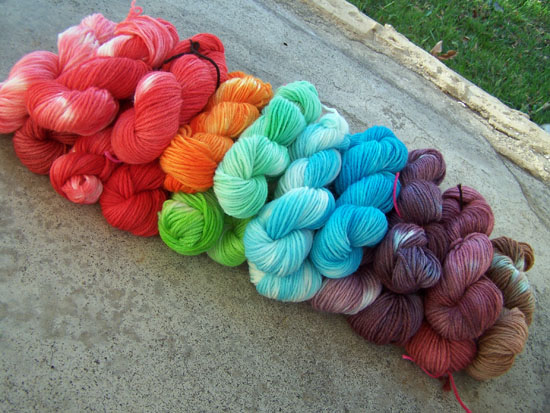
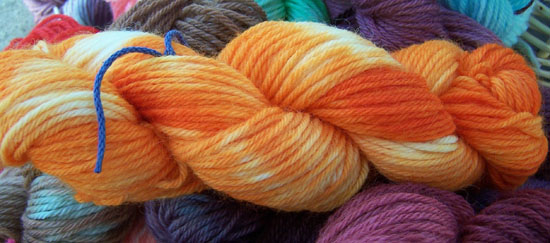

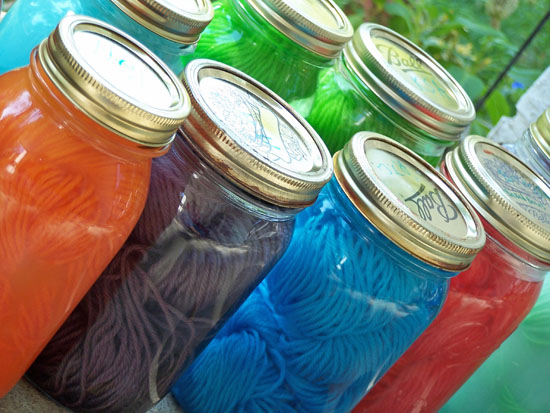
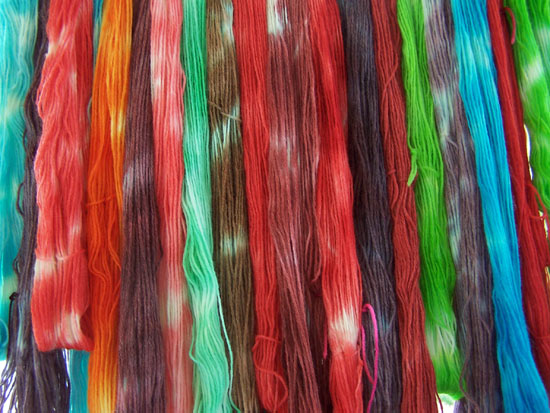
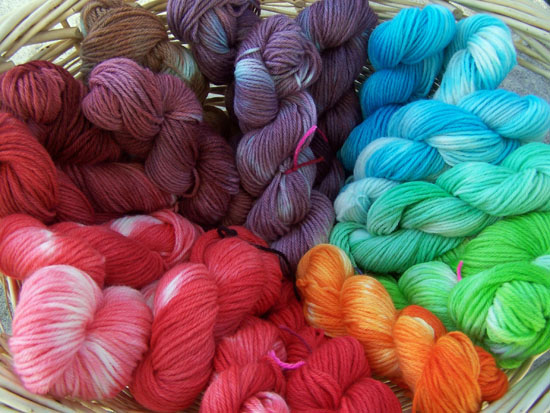
That is SO COOL I just can’t stand it. I will have to try it. How much yarn is in one of those hanks? I mean, what could you knit with one of those? A hat? Hat and mittens for a child?
Thank you Kirky Loo. I am going to link this to my blog if that’s OK. I hope to do this on a warm day this fall.
Cathe, one full hank is 220 yards of worsted weight…plenty for a small child’s hat and pair of mittens, I’d think.
Susan, you’re more than welcome to link. Thanks for the inspiration to write out all the details.
I love Kool-aid dyeing – and your colors are just beautiful!
GOSH! i really really love how dyed yarn turned out!!!
really excited to try this out soon. but i’m not sure if i can find Kool-Aid here in Singapore. 😦
My yarn still smells of kool aid. Any ideas for removing the smell. I have washed more than once, added vinegar, used soak, dried in the sun. Still, the smell is very strong!
Jill, ours had a little bit of the smell left when we were done. It faded before our 10 week term ended, because our final blanket didn’t smell like kool-aid. It sould like you’ve done what I would try…I haven’t had Soak fail me before, as long as I leave it in 30-45 minutes. Out of curiosity, what flavor did you use?
They are beautiful. Can I use something besides a jar? I am eager to do this but I don’t have jars.
I think you could…I’d want to use a closed container so that nothing falls in and liquid doesn’t evaporate out. It would also be good to use one that absorbs rather than reflects heat. Happy dyeing!
This also works well with wilson food coloring as well and the color you get is awsome.
I have heard that, but haven’t tried it yet. It’s amazing to realize there are so many fun options out there for dyeing at home!
Wilson? or Wilton? Do you mean the food gel dyes? How much of it do you use?
Will the color fade out when you wash the finished project?
It shouldn’t! The chemical reaction between the acid in the vinegar and the protein in the wool fiber is what keeps the dye where it belongs. Once you’ve rinsed it until the water is clear, all the residual dye should be gone, and the color that is left should stay true. It’s the same chemical process used by professional hand dyers when they use protein based fibers, including wool and alpaca.
would you be able to use cotton or muslim fabric?
I think you would need a different dye/binding agent since cotton is not a protein based fiber. Cushing makes a line of dyes that are used specifically for cotton and cotton blends. It would be fun to experiment with those as well!
Love coloring wool with kool-aid in the microwave, been doing it for years! You don’t need a special jar. Don’t need the vinegar either since the kool-aid has citric acid. No nasty chemicals so I use Pyrex cake pans or bowls or whatever is nearby. If you aren’t using the heat of the microwave, I guess covering it to keep in the sun’s warmth might be more necessary – I don’t cover mine at all. The fruity smell fades out pretty quickly from my experience (well, weeks at most). I’m prolly still knitting or crocheting the final item still by then.
Nice! I’ve used vinegar each time because that’s how I first learned, but it’d be nice to not have the smell. I know of one very successful professional dyer who uses citric acid exclusively. The more acidic the solution, the quicker the “strike” of the dye. I’ve done a good bit of kettle dyeing, and when I want deep saturation of color without it spreading through the whole pot, I amp up the amount of vinegar significantly.
I really like this idea. I am curious if colors run when garment is washed?!
Haven’t had any trouble with colors running, as long as I’ve made sure to rinse off all the residual dye after dyeing.
WHEN CROCHET SOMETHING YOU WASH IT WILL THE COLOR COME OUT PRETTY DARN COOL THANKS
Haven’t had it happen yet!
Won’t it fade after a few washes? This would be my only concern.
Again, I haven’t had it happen yet, but it might be worth doing a swatch on a small amount of the same kind of wool and washing it a bazillion times as a test.
This type of dye-ing works BEST with animal fibers/blends. It will be VERY muted if you try it with cotton or acrylic (according to other blogs with yarn dye-ing procedures).
I’d love to see that. My own dyeing experience makes me think I’d never be able to get an acid dye to strike and hold on acrylic or cotton. Do you remember where you’ve seen the how-to for that? I’d love to have that link as a resource.
I agree that the colour doesn’t run or fade. I had my grade 4 students dye some roving which I spin and knit into socks. That was 8 years ago and they have been through many, many washes and they continue to be the bright neon green colour that they chose!
Kiersten, I did some research on what to use on cotton crochet thread used in doilies and most sites suggested using tie dye colors for 100% cotton. I haven’t done that yet since I found a sale on thread and bought up a bunch of colors. It makes sense though…t-shirts are made from cotton usually and so is this thread. Could you please advise us about how to make gradiated colors using this method? Or is that not possible? Thanks for the tutorial!